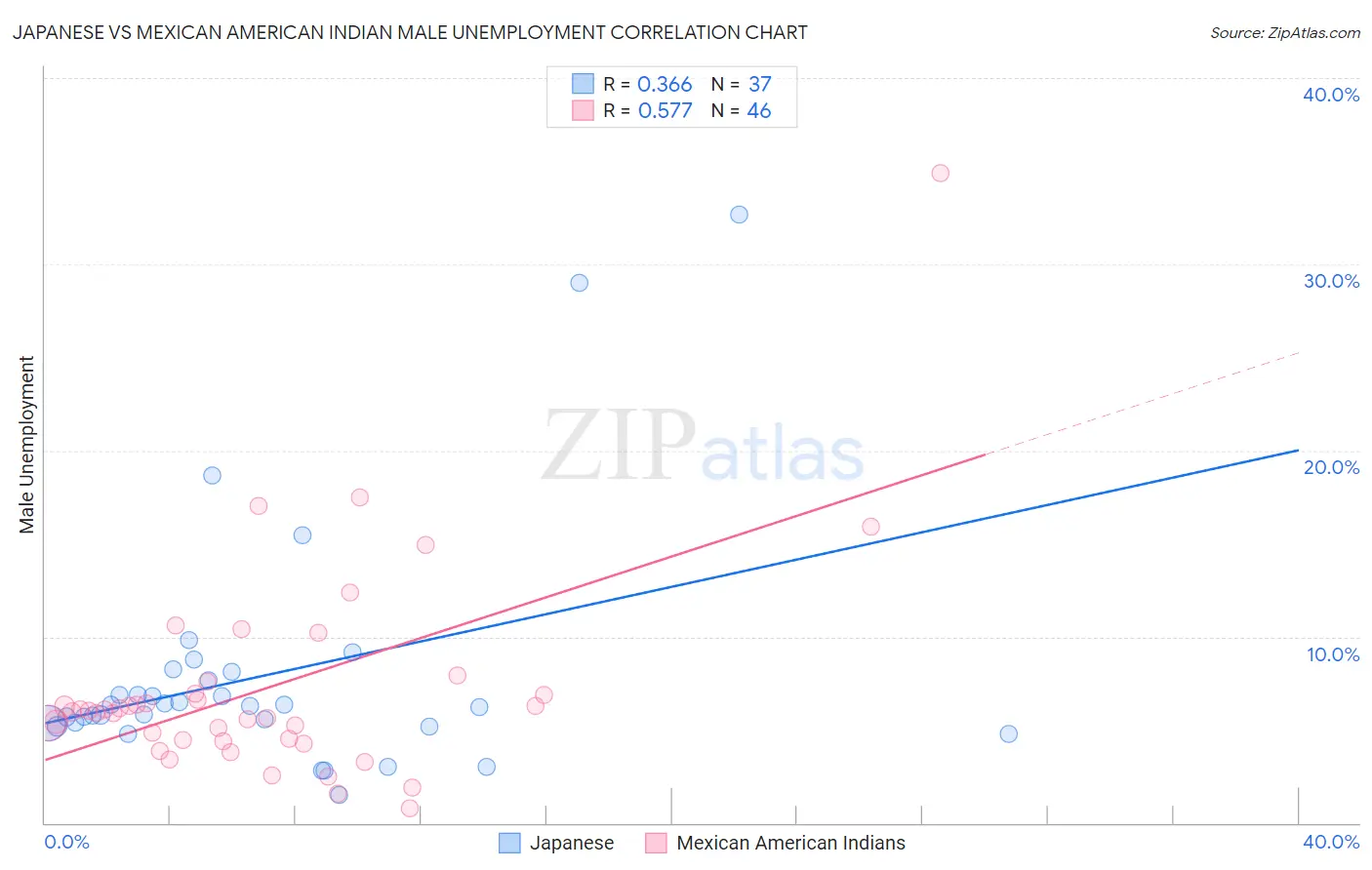Japanese vs Mexican American Indian Male Unemployment
COMPARE
Japanese
Mexican American Indian
Male Unemployment
Male Unemployment Comparison
Japanese
Mexican American Indians
5.8%
MALE UNEMPLOYMENT
0.2/ 100
METRIC RATING
254th/ 347
METRIC RANK
5.8%
MALE UNEMPLOYMENT
0.2/ 100
METRIC RATING
253rd/ 347
METRIC RANK
Japanese vs Mexican American Indian Male Unemployment Correlation Chart
The statistical analysis conducted on geographies consisting of 248,784,678 people shows a mild positive correlation between the proportion of Japanese and unemployment rate among males in the United States with a correlation coefficient (R) of 0.366 and weighted average of 5.8%. Similarly, the statistical analysis conducted on geographies consisting of 316,861,577 people shows a substantial positive correlation between the proportion of Mexican American Indians and unemployment rate among males in the United States with a correlation coefficient (R) of 0.577 and weighted average of 5.8%, a difference of 0.17%.

Male Unemployment Correlation Summary
| Measurement | Japanese | Mexican American Indian |
| Minimum | 1.5% | 0.80% |
| Maximum | 32.7% | 34.9% |
| Range | 31.2% | 34.1% |
| Mean | 7.9% | 7.2% |
| Median | 6.3% | 6.0% |
| Interquartile 25% (IQ1) | 5.3% | 4.4% |
| Interquartile 75% (IQ3) | 7.9% | 6.9% |
| Interquartile Range (IQR) | 2.6% | 2.5% |
| Standard Deviation (Sample) | 6.4% | 5.6% |
| Standard Deviation (Population) | 6.3% | 5.6% |
Demographics Similar to Japanese and Mexican American Indians by Male Unemployment
In terms of male unemployment, the demographic groups most similar to Japanese are Kiowa (5.8%, a difference of 0.10%), Comanche (5.8%, a difference of 0.18%), Mexican (5.8%, a difference of 0.30%), Hispanic or Latino (5.8%, a difference of 0.35%), and Dutch West Indian (5.8%, a difference of 0.49%). Similarly, the demographic groups most similar to Mexican American Indians are Mexican (5.8%, a difference of 0.13%), Kiowa (5.8%, a difference of 0.28%), Comanche (5.8%, a difference of 0.35%), Hispanic or Latino (5.8%, a difference of 0.52%), and Dutch West Indian (5.8%, a difference of 0.66%).
| Demographics | Rating | Rank | Male Unemployment |
| Bangladeshis | 0.8 /100 | #243 | Tragic 5.7% |
| Immigrants | El Salvador | 0.7 /100 | #244 | Tragic 5.7% |
| Yaqui | 0.7 /100 | #245 | Tragic 5.7% |
| Iroquois | 0.6 /100 | #246 | Tragic 5.7% |
| Hawaiians | 0.6 /100 | #247 | Tragic 5.7% |
| Marshallese | 0.5 /100 | #248 | Tragic 5.7% |
| Cree | 0.4 /100 | #249 | Tragic 5.7% |
| Immigrants | Bahamas | 0.4 /100 | #250 | Tragic 5.7% |
| Spanish Americans | 0.3 /100 | #251 | Tragic 5.7% |
| Mexicans | 0.2 /100 | #252 | Tragic 5.8% |
| Mexican American Indians | 0.2 /100 | #253 | Tragic 5.8% |
| Japanese | 0.2 /100 | #254 | Tragic 5.8% |
| Kiowa | 0.2 /100 | #255 | Tragic 5.8% |
| Comanche | 0.2 /100 | #256 | Tragic 5.8% |
| Hispanics or Latinos | 0.1 /100 | #257 | Tragic 5.8% |
| Dutch West Indians | 0.1 /100 | #258 | Tragic 5.8% |
| Cajuns | 0.1 /100 | #259 | Tragic 5.8% |
| Immigrants | Central America | 0.1 /100 | #260 | Tragic 5.8% |
| Liberians | 0.1 /100 | #261 | Tragic 5.8% |
| Immigrants | Portugal | 0.1 /100 | #262 | Tragic 5.9% |
| Immigrants | Latin America | 0.1 /100 | #263 | Tragic 5.9% |